[English] 日本語
 Yorodumi
Yorodumi- PDB-7owd: Structure of CYLD CAP-Gly3 (467-552) bound to Ub; tetragonal spac... -
+ Open data
Open data
- Basic information
Basic information
| Entry | Database: PDB / ID: 7owd | |||||||||
|---|---|---|---|---|---|---|---|---|---|---|
| Title | Structure of CYLD CAP-Gly3 (467-552) bound to Ub; tetragonal space group | |||||||||
 Components Components |
| |||||||||
 Keywords Keywords | IMMUNE SYSTEM / ubiquitin binding domain / deubiquitinating enzyme | |||||||||
| Function / homology |  Function and homology information Function and homology informationnegative regulation of interleukin-18-mediated signaling pathway / Met1-linked polyubiquitin deubiquitinase activity / protein linear deubiquitination / regulation of B cell differentiation / ripoptosome assembly involved in necroptotic process / regulation of intrinsic apoptotic signaling pathway / nucleotide-binding domain, leucine rich repeat containing receptor signaling pathway / regulation of cilium assembly / negative regulation of p38MAPK cascade / regulation of necroptotic process ...negative regulation of interleukin-18-mediated signaling pathway / Met1-linked polyubiquitin deubiquitinase activity / protein linear deubiquitination / regulation of B cell differentiation / ripoptosome assembly involved in necroptotic process / regulation of intrinsic apoptotic signaling pathway / nucleotide-binding domain, leucine rich repeat containing receptor signaling pathway / regulation of cilium assembly / negative regulation of p38MAPK cascade / regulation of necroptotic process / ciliary tip / CD4-positive or CD8-positive, alpha-beta T cell lineage commitment / regulation of tumor necrosis factor-mediated signaling pathway / proline-rich region binding / K48-linked deubiquitinase activity / negative regulation of non-canonical NF-kappaB signal transduction / protein K63-linked deubiquitination / positive regulation of extrinsic apoptotic signaling pathway / negative regulation of JNK cascade / TNFR1-induced proapoptotic signaling / positive regulation of T cell differentiation / negative regulation of type I interferon production / K63-linked deubiquitinase activity / : / necroptotic process / positive regulation of T cell receptor signaling pathway / homeostasis of number of cells / protein deubiquitination / positive regulation of protein localization / Maturation of protein E / negative regulation of canonical NF-kappaB signal transduction / Maturation of protein E / ER Quality Control Compartment (ERQC) / Myoclonic epilepsy of Lafora / FLT3 signaling by CBL mutants / Constitutive Signaling by NOTCH1 HD Domain Mutants / IRAK2 mediated activation of TAK1 complex / Prevention of phagosomal-lysosomal fusion / Alpha-protein kinase 1 signaling pathway / Glycogen synthesis / IRAK1 recruits IKK complex / IRAK1 recruits IKK complex upon TLR7/8 or 9 stimulation / Endosomal Sorting Complex Required For Transport (ESCRT) / Membrane binding and targetting of GAG proteins / Negative regulation of FLT3 / Regulation of TBK1, IKKε (IKBKE)-mediated activation of IRF3, IRF7 / PTK6 Regulates RTKs and Their Effectors AKT1 and DOK1 / Regulation of TBK1, IKKε-mediated activation of IRF3, IRF7 upon TLR3 ligation / IRAK2 mediated activation of TAK1 complex upon TLR7/8 or 9 stimulation / NOTCH2 Activation and Transmission of Signal to the Nucleus / TICAM1,TRAF6-dependent induction of TAK1 complex / TICAM1-dependent activation of IRF3/IRF7 / APC/C:Cdc20 mediated degradation of Cyclin B / Downregulation of ERBB4 signaling / Regulation of FZD by ubiquitination / regulation of mitotic cell cycle / APC-Cdc20 mediated degradation of Nek2A / p75NTR recruits signalling complexes / InlA-mediated entry of Listeria monocytogenes into host cells / TRAF6 mediated IRF7 activation in TLR7/8 or 9 signaling / TRAF6-mediated induction of TAK1 complex within TLR4 complex / Regulation of pyruvate metabolism / NF-kB is activated and signals survival / regulation of microtubule cytoskeleton organization / Regulation of innate immune responses to cytosolic DNA / Pexophagy / Downregulation of ERBB2:ERBB3 signaling / NRIF signals cell death from the nucleus / Regulation of PTEN localization / Activated NOTCH1 Transmits Signal to the Nucleus / VLDLR internalisation and degradation / Regulation of BACH1 activity / Synthesis of active ubiquitin: roles of E1 and E2 enzymes / MAP3K8 (TPL2)-dependent MAPK1/3 activation / Translesion synthesis by REV1 / TICAM1, RIP1-mediated IKK complex recruitment / Translesion synthesis by POLK / InlB-mediated entry of Listeria monocytogenes into host cell / Activation of IRF3, IRF7 mediated by TBK1, IKKε (IKBKE) / JNK (c-Jun kinases) phosphorylation and activation mediated by activated human TAK1 / Josephin domain DUBs / Downregulation of TGF-beta receptor signaling / Translesion synthesis by POLI / IKK complex recruitment mediated by RIP1 / Gap-filling DNA repair synthesis and ligation in GG-NER / Regulation of activated PAK-2p34 by proteasome mediated degradation / PINK1-PRKN Mediated Mitophagy / TGF-beta receptor signaling in EMT (epithelial to mesenchymal transition) / TNFR1-induced NF-kappa-B signaling pathway / Autodegradation of Cdh1 by Cdh1:APC/C / TCF dependent signaling in response to WNT / APC/C:Cdc20 mediated degradation of Securin / Regulation of NF-kappa B signaling / N-glycan trimming in the ER and Calnexin/Calreticulin cycle / activated TAK1 mediates p38 MAPK activation / Asymmetric localization of PCP proteins / SCF-beta-TrCP mediated degradation of Emi1 / NIK-->noncanonical NF-kB signaling / Ubiquitin-dependent degradation of Cyclin D / TNFR2 non-canonical NF-kB pathway Similarity search - Function | |||||||||
| Biological species |  Homo sapiens (human) Homo sapiens (human) | |||||||||
| Method |  X-RAY DIFFRACTION / X-RAY DIFFRACTION /  SYNCHROTRON / SYNCHROTRON /  MOLECULAR REPLACEMENT / Resolution: 1.71 Å MOLECULAR REPLACEMENT / Resolution: 1.71 Å | |||||||||
 Authors Authors | Elliott, P.R. / Komander, D. | |||||||||
| Funding support |  United Kingdom, 2items United Kingdom, 2items
| |||||||||
 Citation Citation |  Journal: Cell Rep / Year: 2021 Journal: Cell Rep / Year: 2021Title: Regulation of CYLD activity and specificity by phosphorylation and ubiquitin-binding CAP-Gly domains. Authors: Elliott, P.R. / Leske, D. / Wagstaff, J. / Schlicher, L. / Berridge, G. / Maslen, S. / Timmermann, F. / Ma, B. / Fischer, R. / Freund, S.M.V. / Komander, D. / Gyrd-Hansen, M. | |||||||||
| History |
|
- Structure visualization
Structure visualization
| Structure viewer | Molecule:  Molmil Molmil Jmol/JSmol Jmol/JSmol |
|---|
- Downloads & links
Downloads & links
- Download
Download
| PDBx/mmCIF format |  7owd.cif.gz 7owd.cif.gz | 127.6 KB | Display |  PDBx/mmCIF format PDBx/mmCIF format |
|---|---|---|---|---|
| PDB format |  pdb7owd.ent.gz pdb7owd.ent.gz | 84 KB | Display |  PDB format PDB format |
| PDBx/mmJSON format |  7owd.json.gz 7owd.json.gz | Tree view |  PDBx/mmJSON format PDBx/mmJSON format | |
| Others |  Other downloads Other downloads |
-Validation report
| Summary document |  7owd_validation.pdf.gz 7owd_validation.pdf.gz | 435 KB | Display |  wwPDB validaton report wwPDB validaton report |
|---|---|---|---|---|
| Full document |  7owd_full_validation.pdf.gz 7owd_full_validation.pdf.gz | 436.4 KB | Display | |
| Data in XML |  7owd_validation.xml.gz 7owd_validation.xml.gz | 9.2 KB | Display | |
| Data in CIF |  7owd_validation.cif.gz 7owd_validation.cif.gz | 12.4 KB | Display | |
| Arichive directory |  https://data.pdbj.org/pub/pdb/validation_reports/ow/7owd https://data.pdbj.org/pub/pdb/validation_reports/ow/7owd ftp://data.pdbj.org/pub/pdb/validation_reports/ow/7owd ftp://data.pdbj.org/pub/pdb/validation_reports/ow/7owd | HTTPS FTP |
-Related structure data
| Related structure data | 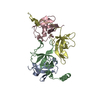 7owcC 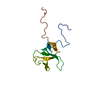 1ixdS 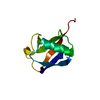 1ubqS C: citing same article ( S: Starting model for refinement |
|---|---|
| Similar structure data |
- Links
Links
- Assembly
Assembly
| Deposited unit | 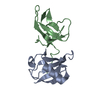
| ||||||||||||
|---|---|---|---|---|---|---|---|---|---|---|---|---|---|
| 1 | 
| ||||||||||||
| 2 | 
| ||||||||||||
| Unit cell |
|
- Components
Components
| #1: Protein | Mass: 9384.731 Da / Num. of mol.: 1 Source method: isolated from a genetically manipulated source Source: (gene. exp.)  Homo sapiens (human) / Gene: CYLD, CYLD1, KIAA0849, HSPC057 / Production host: Homo sapiens (human) / Gene: CYLD, CYLD1, KIAA0849, HSPC057 / Production host:  |
|---|---|
| #2: Protein | Mass: 8576.831 Da / Num. of mol.: 1 Source method: isolated from a genetically manipulated source Source: (gene. exp.)  Homo sapiens (human) / Gene: UBC / Production host: Homo sapiens (human) / Gene: UBC / Production host:  |
| #3: Water | ChemComp-HOH / |
-Experimental details
-Experiment
| Experiment | Method:  X-RAY DIFFRACTION / Number of used crystals: 1 X-RAY DIFFRACTION / Number of used crystals: 1 |
|---|
- Sample preparation
Sample preparation
| Crystal | Density Matthews: 2.02 Å3/Da / Density % sol: 39 % |
|---|---|
| Crystal grow | Temperature: 291 K / Method: vapor diffusion, sitting drop / pH: 4.2 / Details: 40 (v/v) PEG 300, 100 mM phosphate/citrate pH 4.2 |
-Data collection
| Diffraction | Mean temperature: 210 K / Serial crystal experiment: N |
|---|---|
| Diffraction source | Source:  SYNCHROTRON / Site: SYNCHROTRON / Site:  Diamond Diamond  / Beamline: I03 / Wavelength: 0.96863 Å / Beamline: I03 / Wavelength: 0.96863 Å |
| Detector | Type: DECTRIS EIGER2 XE 16M / Detector: PIXEL / Date: Apr 15, 2018 |
| Radiation | Protocol: SINGLE WAVELENGTH / Monochromatic (M) / Laue (L): M / Scattering type: x-ray |
| Radiation wavelength | Wavelength: 0.96863 Å / Relative weight: 1 |
| Reflection | Resolution: 1.71→41.64 Å / Num. obs: 18356 / % possible obs: 100 % / Redundancy: 6 % / Biso Wilson estimate: 35.32 Å2 / CC1/2: 0.998 / Net I/σ(I): 15 |
| Reflection shell | Resolution: 1.71→1.74 Å / Mean I/σ(I) obs: 1.9 / Num. unique obs: 933 / CC1/2: 0.899 |
- Processing
Processing
| Software |
| |||||||||||||||||||||||||||||||||||||||||||||||||||||||||||||||||||||||||||
|---|---|---|---|---|---|---|---|---|---|---|---|---|---|---|---|---|---|---|---|---|---|---|---|---|---|---|---|---|---|---|---|---|---|---|---|---|---|---|---|---|---|---|---|---|---|---|---|---|---|---|---|---|---|---|---|---|---|---|---|---|---|---|---|---|---|---|---|---|---|---|---|---|---|---|---|---|
| Refinement | Method to determine structure:  MOLECULAR REPLACEMENT MOLECULAR REPLACEMENTStarting model: 1UBQ, 1IXD Resolution: 1.71→41.64 Å / SU ML: 0.2669 / Cross valid method: FREE R-VALUE / σ(F): 1.45 / Phase error: 34.1202 Stereochemistry target values: GeoStd + Monomer Library + CDL v1.2
| |||||||||||||||||||||||||||||||||||||||||||||||||||||||||||||||||||||||||||
| Solvent computation | Shrinkage radii: 0.9 Å / VDW probe radii: 1.11 Å / Solvent model: FLAT BULK SOLVENT MODEL | |||||||||||||||||||||||||||||||||||||||||||||||||||||||||||||||||||||||||||
| Displacement parameters | Biso mean: 52.67 Å2 | |||||||||||||||||||||||||||||||||||||||||||||||||||||||||||||||||||||||||||
| Refinement step | Cycle: LAST / Resolution: 1.71→41.64 Å
| |||||||||||||||||||||||||||||||||||||||||||||||||||||||||||||||||||||||||||
| Refine LS restraints |
| |||||||||||||||||||||||||||||||||||||||||||||||||||||||||||||||||||||||||||
| LS refinement shell |
| |||||||||||||||||||||||||||||||||||||||||||||||||||||||||||||||||||||||||||
| Refinement TLS params. | Method: refined / Refine-ID: X-RAY DIFFRACTION
| |||||||||||||||||||||||||||||||||||||||||||||||||||||||||||||||||||||||||||
| Refinement TLS group |
|
 Movie
Movie Controller
Controller


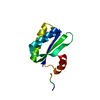
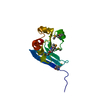


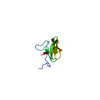

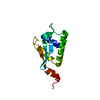
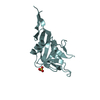
 PDBj
PDBj

















